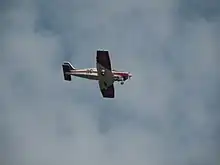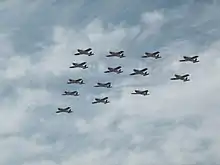ENAER T-35 Pillán
ENAER T-35 Pillán (Spanish pronunciation: [piˈʎan], Mapudungún: volcano or ancestral spirit) is a Chilean propeller-driven basic trainer aircraft. The student and the instructor sit in tandem. Production ceased in 1991 after 7 years but restarted briefly in 1998.[2]
| T-35 Pillán | |
|---|---|
_Lofting.jpg.webp) | |
| An ENAER T-35 Pillán of the Spanish Air and Space Force | |
| Role | Trainer |
| National origin | Chile |
| Manufacturer | ENAER |
| First flight | 6 March 1981[1] |
| Status | In service |
| Primary users | Chilean Air Force Spanish Air and Space Force National Air and Naval Service of Panama Paraguayan Air Force |
| Produced | 28 December 1984[1] – 1991 |
| Number built | 154[2] |
Design and development
Prior to the eighties Chile possessed a decrepit fleet of military trainers obtained under the Mutual Defense Assistance Act. However, these trainers had become exceedingly difficult to repair following passage of a US arms embargo in 1976.[3] The PA-28R-300 Pillán was developed by Piper Aircraft in the United States as a two-seat military trainer for assembly in Chile, based on a PA-32R fuselage with a new center-section and wing stressed for aerobatics.[4] The first prototype designated XBT first flew at Lakeland on 6 March 1981 and was followed by a second prototype, designated YBT.[4] The second prototype first flew on 31 August 1981 and was then delivered to Chile.[4] The prototype XBT was delivered to Chile in January 1982 but was written off on 10 March 1982.[4] Production of kits at Vero Beach Municipal Airport commenced with three pre-production kits which were delivered for assembly in Chile in 1982, Vero Beach then produced 120 kits for assembly in Chile for the Chilean and Spanish Air Force.[4] The first production aircraft was delivered by ENAER to the Chilean Air Force Air Academy in August 1985.[4] The Spanish aircraft were assembled in Spain by CASA.[1]
Apart from a few turbine powered aircraft, all Pilláns were powered by a 300 hp (224 kW) Textron Lycoming AEIO-540-K1K5 six cylinder horizontally opposed piston engine.
In 1985 a turboprop variant was developed by ENAER as the T-35A Aucan.[4] In early 1986 one of the piston-engined pre-production aircraft was sent to Soloy Aviation Solutions in the United States for modification to install a 420 shp Allison 250B-17D engine.[4]
Variants

- Piper PA-28R-300 Pillan
- Two Piper built prototypes.[4]
- T-35A
- Two-seat primary training aircraft for the Chilean Air Force. 60 delivered by 1990.[5]
- T-35B
- Two-seat instrument training aircraft for the Chilean Air Force. 20 delivered by 1990.[5]
- T-35C
- Two-seat primary training aircraft for the Spanish Air and Space Force, known as the E.26 Tamiz. 41 delivered by 1987.[5]
- T-35D
- Two-seat primary and instrument training aircraft for Panama and Paraguay.[6]
- T-35DT
- Turboprop powered version, powered by a 420-ehp (313-kW) Allison 250-B17D turboprop engine. Original designation T-35XT.
- T-35S
- Single-seat aerobatic aircraft.[6]
- T-35T Aucan
- Improved turboprop powered version.
- Pillan 2000
- Proposed (1998) updated version of the T-35 Pillan with new wing.[7]
Operators

- Chilean Air Force operates 31 aircraft as of 2017.[8]
- Dominican Air Force operates four aircraft as of 2017.[9]
- Ecuadorian Navy – operates three as of 2017.[9]
- Air Force of El Salvador – operates three as of 2017.[9]
- Guatemalan Air Force – operates four as of 2017.[10]
- National Air and Naval Service of Panama – operates four as of 2017.[11]
- Paraguayan Air Force – operates 9 as of 2017.[11]
- Spanish Air and Space Force – ordered 41, operates 35 as of 2017.[12]
Specifications (T-35A)
Data from Jane's all the World's Aircraft 1988–89[13]
General characteristics
- Crew: 2
- Length: 8 m (26 ft 3 in)
- Wingspan: 8.84 m (29 ft 0 in)
- Height: 2.64 m (8 ft 8 in)
- Wing area: 13.69 m2 (147.4 sq ft)
- Airfoil: root: NACA 652-415 ; tip: NACA 652-415 modified
- Empty weight: 930 kg (2,050 lb) equipped
- Max takeoff weight: 1,338 kg (2,950 lb) (and Maximum Landing Weight)
- 1,315 kg (2,899 lb) aerobatic
- Fuel capacity: 291.5 L (77.0 US gal; 64.1 imp gal) in two wing leading edge integral tanks / 210 kg (463 lb) (272.5 L (72.0 US gal; 59.9 imp gal) usable)
- Powerplant: 1 × Avco Lycoming AEIO-540-K1K5 6-cylinder air-cooled horizontally-opposed piston engine, 224 kW (300 hp)
- Propellers: 3-bladed Hartzell HC-C3YR-4BF/FC7663R, 1.93 m (6 ft 4 in) diameter constant-speed propeller
Performance
- Maximum speed: 311 km/h (193 mph, 168 kn) at sea level
- Cruise speed: 266 km/h (165 mph, 144 kn) 75% power at 2,680 m (8,793 ft)
- 255 km/h (158 mph; 138 kn) 55% power at 5,120 m (16,798 ft)
- Stall speed: 125 km/h (78 mph, 67 kn) flaps up
- 115 km/h (71 mph; 62 kn) flaps down
- Maximum flap extension speed: 218 km/h (135 mph; 118 kn)
- Maximum undercarriage extension speed: 256 km/h (159 mph; 138 kn)
- Approach speed over 15 m (49 ft) obstacle: 148 km/h (92 mph; 80 kn)
- Landing speed: 120 km/h (75 mph; 65 kn)
- Never exceed speed: 446 km/h (277 mph, 241 kn)
- Range: 1,093 km (679 mi, 590 nmi) 75% power at 2,440 m (8,005 ft) (45 minutes reserve)
- 1,204 km (748 mi; 650 nmi) 55% power at 3,660 m (12,008 ft) (45 minutes reserve)
- 1,260 km (780 mi; 680 nmi) 75% power at 3,660 m (12,008 ft) (no reserve)
- 1,362 km (846 mi; 735 nmi) 55% power at 3,660 m (12,008 ft) (no reserve)
- Endurance: 75% power at sea level 4 hours 24 minutes
- 55% power at sea level 5 hours 36 minutes
- Service ceiling: 5,840 m (19,160 ft)
- Absolute ceiling: 6,250 m (20,505 ft)
- g limits: +6 -3
- Rate of climb: 7.75 m/s (1,526 ft/min)
- Time to altitude: 1,830 m (6,004 ft) in 4 minutes 42 seconds
- 3,050 m (10,007 ft) in 8 minutes 48 seconds
- Wing loading: 97.73 kg/m2 (20.02 lb/sq ft)
- Power/mass: 0.167 kW/kg (0.102 hp/lb)
- Take-off run: 287 m (942 ft)
- Take-off distance to 15 m (49 ft): 494 m (1,621 ft)
- Landing run: 238 m (781 ft)
- Landing distance from 15 m (49 ft): 509 m (1,670 ft)
Avionics
- 2x Collins VHF
- CollinsV1R VOR
- Collins ADF-650A
- Collins TOR-950 IFF
- King KTR 908 with 2X King KFS 598A control units
- 2x King KMA 244 audio panels
- 2x King KR 87 ADF
- (Blind-flying instruments with full IFR capability in T-35B)
See also
Related development
Aircraft of comparable role, configuration, and era
Notes
- Green 1988, pp. 98–9
- Endres, Gunther; Gething, Mike (2002). Jane's Aircraft Recognition Guide. Glasgow, UK: HarperCollinsPublishers. p. 392. ISBN 0-00-713721-4.
- John R. Bawden,"Cutting Off the Dictator: the United States Arms Embargo of the Pinochet Regime, 1974–1988", Journal of Latin American Studies, 45:3 (August 2013): 513–43.
- Peperell & Smith 1987, p. 159
- Lambert 1990, p. 30
- Jackson 2003, p. 71
- Jackson 2003, p. 72
- Hoyle 2017, p. 36
- Hoyle 2017, p. 38
- Hoyle 2017, p. 41
- Hoyle 2017, p. 48
- Hoyle 2017, p. 51
- Taylor, John W.R., ed. (1988). Jane's all the World's Aircraft 1988–89 (79th ed.). London: Jane's Information Group. pp. 32–33. ISBN 0-7106-0867-5.
References
- "Hecho En Chile...An Innocuous Devil". Air International. Vol. 28, no. 4. April 1985. pp. 170–175, 208–209.
- Hoyle, Craig (5–11 December 2017). "World Air Force Directory". Flight International. Vol. 192, no. 5615. pp. 26–57. ISSN 0015-3710.
- Jackson, Paul, ed. (2003). Jane's All the World's Aircraft 2003–2004. Coulsdon, UK: Jane's Information Group. ISBN 0-7106-2537-5.
- Lambert, Mark, ed. (1990). Jane's All the World's Aircraft 1990–91. Coulsdon, UK: Jane's Defence Data. ISBN 0-7106-0908-6.
- Peperell, Roger W; Smith, Colin M (1987). Piper Aircraft and their forerunners. Tonbridge, Kent, England: Air-Britain. ISBN 0-85130-149-5.
- Green, William (1988). Observer's book of aircraft (1988 ed.). London: Frederick Warne & Co. Ltd.